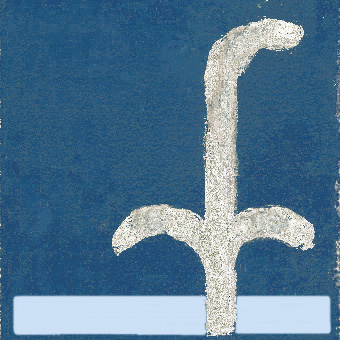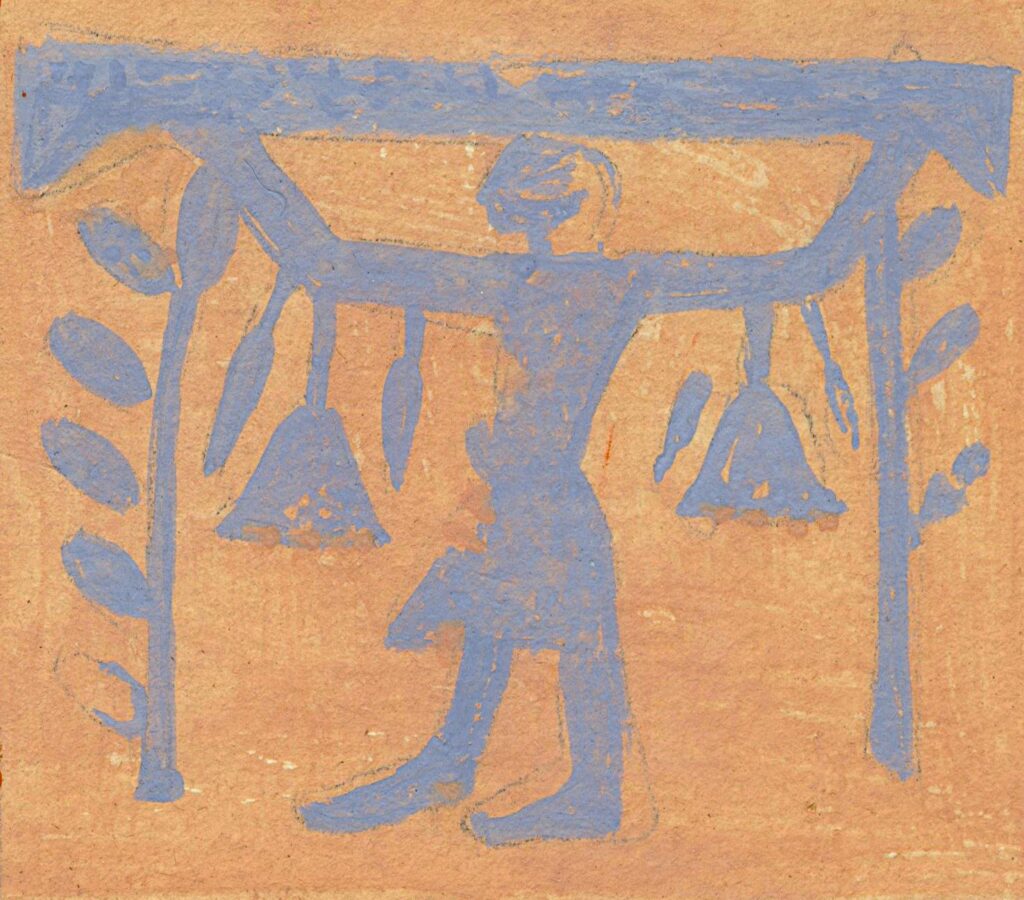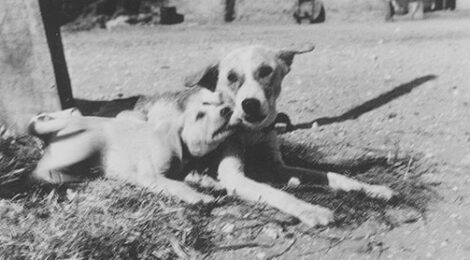
Animals – 2: Camp dogs – 2
Author: Susan Biddle.
Myrtle Broome’s love of animals shines through many of her letters. This post is one of a series looking at the animals she encountered, and is the second of two focusing on the dogs which guarded the dig house.
After their first dig house dog, Wip-wat, died in November 1933, another dog was essential to guard the dig house and no time was wasted in securing a replacement. In her very next letter after reporting Wip-wat’s death, Myrtle told her mother: “we have a lovely little pup here now. Sardic [the head servant] has brought his bitch & her dog pup of one month to stay here”. Wip-wat had been the new puppy’s father.
They hoped that, if the puppy grew up at the dig house and remembered no other home, he would be happy to remain at the dig house and would not run off to the village even if not chained. Until he grew up a little, his mother fulfilled the role of guard dog. Many of the letters during the 1933–1934 season reported on the pup’s progress. On 1 December 1933 Myrtle told her mother that “the puppy is getting on famously. I am teaching him to sit up when I feed him, at present he has to rest his little paws on my hand but I think he will sit up on his own by & by”. The following week she reported that “our pup is getting on splendidly & is in every sort of mischief. All the men spoil him. He sleeps with them in their room as they are afraid the jackals might get him at night if he stayed out with his mother. He cuddles up to one of them for warmth”. A few days before Christmas Myrtle told her mother that “the puppy is a very cute little fellow & leads his patient mother a dog’s life. I have had to smack him for biting her ears & making them bleed”.
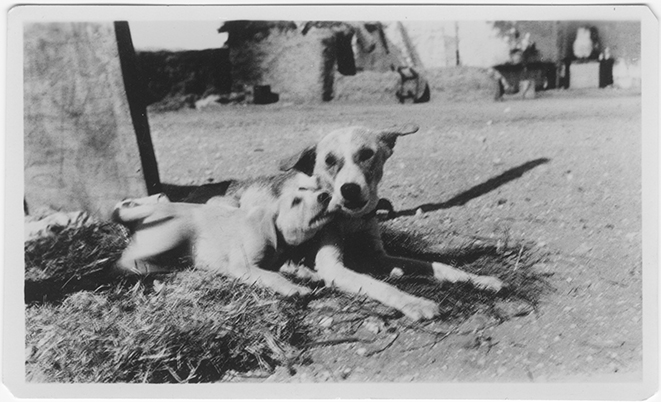
Photograph by Myrtle Broome (1934)
Letter 274
Amice did not arrive at Baliana that year until after Christmas, and the team decided to wait for her to name the puppy. In the meantime all the servants called the puppy “Wip-wat” like the previous dog. When Amice did arrive, she “decided that the pup is to be Wip-wat the second”. By early February Wip-wat junior was “beginning to find that life is not all fun. He is getting big & very mischievous & now has to be sometimes tied up & is simply enraged at the indignity”. He was big enough to jump over the garden wall which infuriated Nannie, the Syrian housekeeper, who grew flowers, salad, and vegetables there. Nannie had a fine line in invective for all those, human or animal, who damaged her garden, and Myrtle told her mother that “the things [Nannie] says to [the puppy] are simply awful. She hopes he may be the last of his race, that he may have a pain in his stomach, & leprosy in his eyes & a few other unpleasant things”, but “fortunately none of these curses seem to affect the pup”.
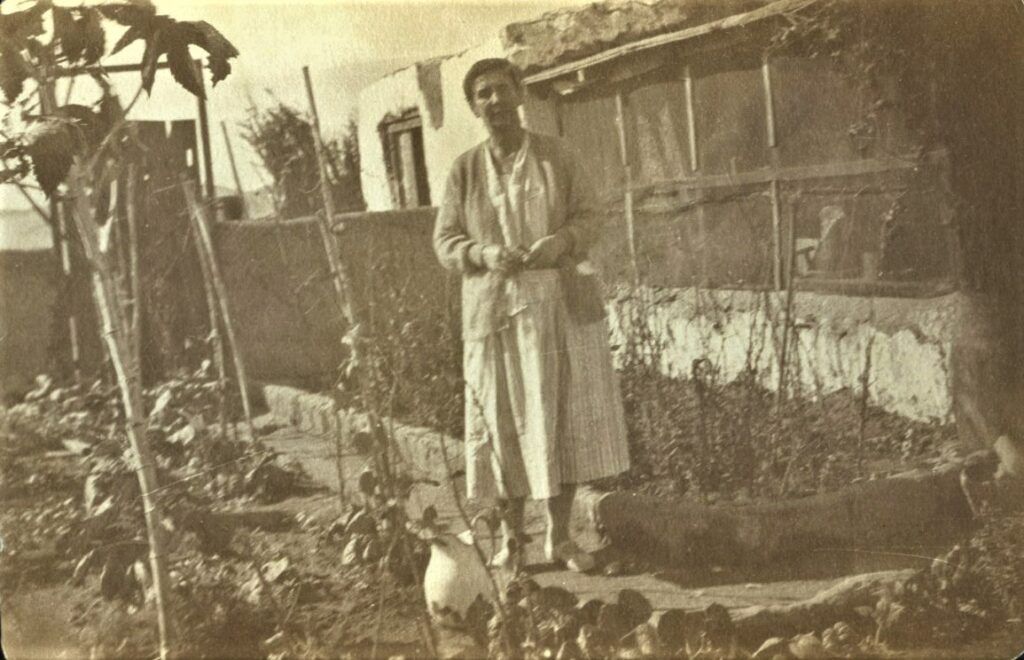
Photograph by Myrtle Broome (probably 1929)
Bushey Museum & Art Gallery
At the end of February they acquired a second puppy, a gift from the local doctor. This was an Armenti, which Myrtle explained to her mother is “a breed very much sought after here as they are excellent guards”. The two puppies were “excellent friends & play together”; Myrtle hoped that “if they have each other’s company they will be content to say out here all the time”. They named the new puppy “Hakim”, meaning “doctor”, after his donor. She described the breed as “rather like sheep dogs”; the puppy was seven or eight weeks’ old and was “like a little fluffy ball, yellow & dark brown with a smutty nose”.
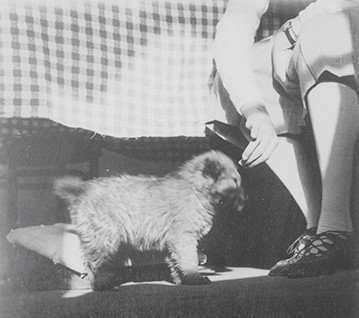
“Isn’t he a lovely little ball of fluff”
Photograph by Myrtle Broome (1934)
Letter 274
By mid-March both puppies were “flourishing & a constant source of trouble to Nannie as they will get over the wall into her garden with lamentable results”. At the end of March, Hakim had his first bath. Although “very alarmed at first”, “after a bit he rather liked the sensation of being rubbed & trickles of warm water running over him”. Myrtle told her mother that “he was a pathetic object when I lifted him out [but] … he was dry in ten minutes & looked wonderful, his hair is apricot colour near the skin with black tips to the long hairs”.
By 27 March Wip-wat junior’s mother Fill-fill had returned to her own home with Sardic in the village. Myrtle reported that Wip-wat II was “doing his duty splendidly”; at the time she was writing her letter, he was “barking furiously at some bedawins who are passing with their flocks. … Hakim has not started to take life quite as seriously yet, but occasionally joins in the chorus with his tail wagging all the time”. Life even for Wip-wat was not all duty – in her next letter Myrtle told her mother that “Wip-wat & Hakim always come running to meet us when we return & expect us to have a game with them, they are very good friends & Wip-wat does not seem to miss his mother at all”.
When she arrived back at Baliana for the start of the next season on 1 November 1934, Myrtle told her father that she “found everyone flourishing – the dogs have grown a lot & they knew me again”. Hakim looked very smart in a new green collar, but was “in the long-legged lean stage now & not nearly as attractive as he was when we left”. However “Wip-wat the second is going to be as fine a dog as his father & is very intelligent”. One of her first tasks was to make a collar for Wip-wat – the strap she had given him for a collar the previous April had disappeared without trace, and she “could not bear to see Wip-wat with a bit of rope tied round his neck”. From the leg of an old boot she made him a hand-sewn leather collar, in which he looked “very smart”. She thought Wip-wat the second was “much the nicer dog of the two. Very affectionate to his friends, a raging fury to all strangers & has beautiful polite dog manners. Hakim is rather disappointing, he has not got the keen sense of who belongs here & who does not, but just barks for no special reason & gets quite hysterical. He may improve as he gets older, just now he is in the awkward age between puppy & dog hood”.
Sadly they never found out whether Hakim would have improved with age. At the start of the following March Myrtle had to report that “Amice & I had a very grim task the other evening, Hakim got some sort of illness, it might have been distemper, he was in a very miserable state for several days, nose, eyes & mouth all discharging & probably very infectious, so it seemed wisest to put him to sleep. We made a bag of a pair of old breeches, soaked a pad of cotton wool with ether, & held it over his head. He was unconscious in less than a minute, & we kept adding ether until his heart stopped. He was a very silly useless sort of dog & difficult to give medicine to, he would get annoyed & snap”. A vaccine against distemper was not available until the early 1930s, so it is not surprising that the camp dogs had not been vaccinated. By contrast with Hakim, Myrtle told her mother that Wip-wat “will let us do anything to him, he chaffed the inside of his leg raw one day with his chain & I put some iodine on it, it stung him & made him yelp, but the next moment he was licking my hand”. They were “very afraid [Wip-wat] might have caught the illness from Hakim”, so gave him “a good dose of castor oil. He took it like a lamb, & up to now continues in excellent health”, and so they hoped he had escaped.
A month later, Myrtle reported back home: “Wip-wat is in splendid health, he has been much better since Hakim’s departure”. Hakim had been a greedy dog and they thought Hakim “gulped his own share down & then stole Wip-wat’s meal as well; as Wip-wat is not greedy & eats slowly, so he never got his full share when Hakim was alive”. Wip-wat did not eat more than he needed and buried any bread left over from his meals, to dig up later when he was hungry. This raised its own problems – a little later Myrtle reported to her mother that Wip-wat had been “discovered burying one [of his loaves of bread] in the sand heap in our sand closet (ie WC only there is S instead of W) … we were very amused but have done our best to discourage him”.
In November 1935 Wip-wat “got a sort of boil on his hind leg”. It did not seem to hurt him much as he still “bounces about quite energetically”. They “put a hot Sanisol dressing on” one evening “& he had quite a busy time chewing it off”; Myrtle hoped he liked the flavour. The treatment was effective – early in December Myrtle could report “Wip-wat is very well. His leg has healed up perfectly”. A week later however she thought he was looking out of sorts despite having a good appetite so “suspected worms. I told the men to keep him all day without food, & this evening at sunset I made him a nice parcel of a lump of meet with a Bob Martin Worm Powder concealed inside. He was so hungry that he ate it all up but it was quite obvious he didn’t think much of the flavour of the meat”.
The following year Wip-wat was enjoying himself in other ways. In November 1936 Myrtle told her mother “our dog is being led astray by a disreputable lady dog who will run after him. Our men chase her away but she will sneak back again. She is no beauty but very determined, she is black & he is white so will the puppies be grey or piebald?”.
Sources:
Letters:
56, 207, 244, 248, 250, 253, 259, 266, 272, 274, 276, 280, 281, 295, 297, 300, 326,332, 334, 348, 355, 257, 385.
With thanks to:
- the Griffith Institute, University of Oxford, for the opportunity to work on the Broome collection, and for their ongoing support for this blog
- the Bushey Museum and Art Gallery, for Myrtle Broome’s photographs
